Yue Shen
DJI Innovations Inc
Iterative Optimal Attention and Local Model for Single Image Rain Streak Removal
Mar 20, 2025Abstract:High-fidelity imaging is crucial for the successful safety supervision and intelligent deployment of vision-based measurement systems (VBMS). It ensures high-quality imaging in VBMS, which is fundamental for reliable visual measurement and analysis. However, imaging quality can be significantly impaired by adverse weather conditions, particularly rain, leading to blurred images and reduced contrast. Such impairments increase the risk of inaccurate evaluations and misinterpretations in VBMS. To address these limitations, we propose an Expectation Maximization Reconstruction Transformer (EMResformer) for single image rain streak removal. The EMResformer retains the key self-attention values for feature aggregation, enhancing local features to produce superior image reconstruction. Specifically, we propose an Expectation Maximization Block seamlessly integrated into the single image rain streak removal network, enhancing its ability to eliminate superfluous information and restore a cleaner background image. Additionally, to further enhance local information for improved detail rendition, we introduce a Local Model Residual Block, which integrates two local model blocks along with a sequence of convolutions and activation functions. This integration synergistically facilitates the extraction of more pertinent features for enhanced single image rain streak removal. Extensive experiments validate that our proposed EMResformer surpasses current state-of-the-art single image rain streak removal methods on both synthetic and real-world datasets, achieving an improved balance between model complexity and single image deraining performance. Furthermore, we evaluate the effectiveness of our method in VBMS scenarios, demonstrating that high-quality imaging significantly improves the accuracy and reliability of VBMS tasks.
DMT-HI: MOE-based Hyperbolic Interpretable Deep Manifold Transformation for Unspervised Dimensionality Reduction
Oct 25, 2024



Abstract:Dimensionality reduction (DR) plays a crucial role in various fields, including data engineering and visualization, by simplifying complex datasets while retaining essential information. However, the challenge of balancing DR accuracy and interpretability remains crucial, particularly for users dealing with high-dimensional data. Traditional DR methods often face a trade-off between precision and transparency, where optimizing for performance can lead to reduced interpretability, and vice versa. This limitation is especially prominent in real-world applications such as image, tabular, and text data analysis, where both accuracy and interpretability are critical. To address these challenges, this work introduces the MOE-based Hyperbolic Interpretable Deep Manifold Transformation (DMT-HI). The proposed approach combines hyperbolic embeddings, which effectively capture complex hierarchical structures, with Mixture of Experts (MOE) models, which dynamically allocate tasks based on input features. DMT-HI enhances DR accuracy by leveraging hyperbolic embeddings to represent the hierarchical nature of data, while also improving interpretability by explicitly linking input data, embedding outcomes, and key features through the MOE structure. Extensive experiments demonstrate that DMT-HI consistently achieves superior performance in both DR accuracy and model interpretability, making it a robust solution for complex data analysis. The code is available at \url{https://github.com/zangzelin/code_dmthi}.
KiloBot: A Programming Language for Deploying Perception-Guided Industrial Manipulators at Scale
Sep 05, 2024Abstract:We would like industrial robots to handle unstructured environments with cameras and perception pipelines. In contrast to traditional industrial robots that replay offline-crafted trajectories, online behavior planning is required for these perception-guided industrial applications. Aside from perception and planning algorithms, deploying perception-guided manipulators also requires substantial effort in integration. One approach is writing scripts in a traditional language (such as Python) to construct the planning problem and perform integration with other algorithmic modules & external devices. While scripting in Python is feasible for a handful of robots and applications, deploying perception-guided manipulation at scale (e.g., more than 10000 robot workstations in over 2000 customer sites) becomes intractable. To resolve this challenge, we propose a Domain-Specific Language (DSL) for perception-guided manipulation applications. To scale up the deployment,our DSL provides: 1) an easily accessible interface to construct & solve a sub-class of Task and Motion Planning (TAMP) problems that are important in practical applications; and 2) a mechanism to implement flexible control flow to perform integration and address customized requirements of distinct industrial application. Combined with an intuitive graphical programming frontend, our DSL is mainly used by machine operators without coding experience in traditional programming languages. Within hours of training, operators are capable of orchestrating interesting sophisticated manipulation behaviors with our DSL. Extensive practical deployments demonstrate the efficacy of our method.
RuleAlign: Making Large Language Models Better Physicians with Diagnostic Rule Alignment
Aug 22, 2024Abstract:Large Language Models (LLMs) like GPT-4, MedPaLM-2, and Med-Gemini achieve performance competitively with human experts across various medical benchmarks. However, they still face challenges in making professional diagnoses akin to physicians, particularly in efficiently gathering patient information and reasoning the final diagnosis. To this end, we introduce the RuleAlign framework, designed to align LLMs with specific diagnostic rules. We develop a medical dialogue dataset comprising rule-based communications between patients and physicians and design an alignment learning approach through preference learning. Experimental results demonstrate the effectiveness of the proposed approach. We hope that our work can serve as an inspiration for exploring the potential of LLMs as AI physicians.
Learning to Plan for Retrieval-Augmented Large Language Models from Knowledge Graphs
Jun 20, 2024



Abstract:Improving the performance of large language models (LLMs) in complex question-answering (QA) scenarios has always been a research focal point. Recent studies have attempted to enhance LLMs' performance by combining step-wise planning with external retrieval. While effective for advanced models like GPT-3.5, smaller LLMs face challenges in decomposing complex questions, necessitating supervised fine-tuning. Previous work has relied on manual annotation and knowledge distillation from teacher LLMs, which are time-consuming and not accurate enough. In this paper, we introduce a novel framework for enhancing LLMs' planning capabilities by using planning data derived from knowledge graphs (KGs). LLMs fine-tuned with this data have improved planning capabilities, better equipping them to handle complex QA tasks that involve retrieval. Evaluations on multiple datasets, including our newly proposed benchmark, highlight the effectiveness of our framework and the benefits of KG-derived planning data.
A Survey on Medical Large Language Models: Technology, Application, Trustworthiness, and Future Directions
Jun 06, 2024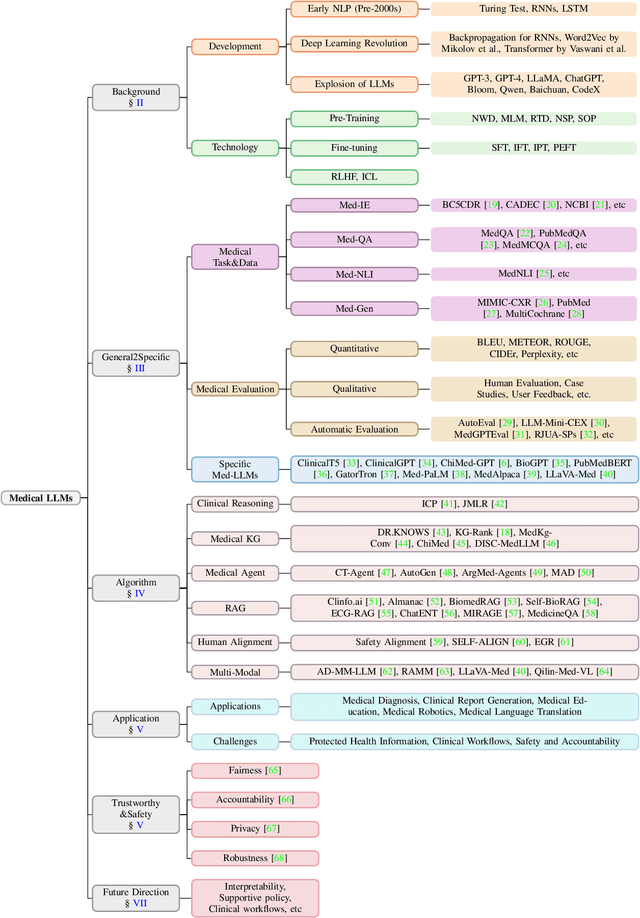
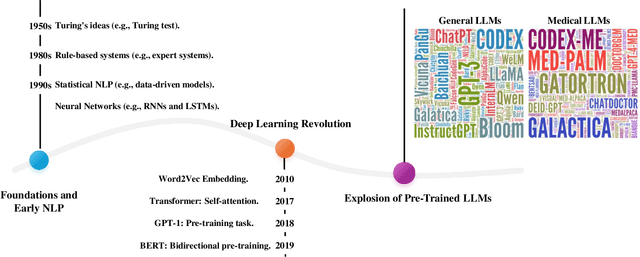


Abstract:Large language models (LLMs), such as GPT series models, have received substantial attention due to their impressive capabilities for generating and understanding human-level language. More recently, LLMs have emerged as an innovative and powerful adjunct in the medical field, transforming traditional practices and heralding a new era of enhanced healthcare services. This survey provides a comprehensive overview of Medical Large Language Models (Med-LLMs), outlining their evolution from general to the medical-specific domain (i.e, Technology and Application), as well as their transformative impact on healthcare (e.g., Trustworthiness and Safety). Concretely, starting from the fundamental history and technology of LLMs, we first delve into the progressive adaptation and refinements of general LLM models in the medical domain, especially emphasizing the advanced algorithms that boost the LLMs' performance in handling complicated medical environments, including clinical reasoning, knowledge graph, retrieval-augmented generation, human alignment, and multi-modal learning. Secondly, we explore the extensive applications of Med-LLMs across domains such as clinical decision support, report generation, and medical education, illustrating their potential to streamline healthcare services and augment patient outcomes. Finally, recognizing the imperative and responsible innovation, we discuss the challenges of ensuring fairness, accountability, privacy, and robustness in Med-LLMs applications. Finally, we conduct a concise discussion for anticipating possible future trajectories of Med-LLMs, identifying avenues for the prudent expansion of Med-LLMs. By consolidating above-mentioned insights, this review seeks to provide a comprehensive investigation of the potential strengths and limitations of Med-LLMs for professionals and researchers, ensuring a responsible landscape in the healthcare setting.
Similarity is Not All You Need: Endowing Retrieval Augmented Generation with Multi Layered Thoughts
May 30, 2024



Abstract:In recent years, large language models (LLMs) have made remarkable achievements in various domains. However, the untimeliness and cost of knowledge updates coupled with hallucination issues of LLMs have curtailed their applications in knowledge intensive tasks, where retrieval augmented generation (RAG) can be of help. Nevertheless, existing retrieval augmented models typically use similarity as a bridge between queries and documents and follow a retrieve then read procedure. In this work, we argue that similarity is not always the panacea and totally relying on similarity would sometimes degrade the performance of retrieval augmented generation. To this end, we propose MetRag, a Multi layEred Thoughts enhanced Retrieval Augmented Generation framework. To begin with, beyond existing similarity oriented thought, we embrace a small scale utility model that draws supervision from an LLM for utility oriented thought and further come up with a smarter model by comprehensively combining the similarity and utility oriented thoughts. Furthermore, given the fact that the retrieved document set tends to be huge and using them in isolation makes it difficult to capture the commonalities and characteristics among them, we propose to make an LLM as a task adaptive summarizer to endow retrieval augmented generation with compactness-oriented thought. Finally, with multi layered thoughts from the precedent stages, an LLM is called for knowledge augmented generation. Extensive experiments on knowledge-intensive tasks have demonstrated the superiority of MetRag.
Towards Automatic Evaluation for LLMs' Clinical Capabilities: Metric, Data, and Algorithm
Mar 25, 2024



Abstract:Large language models (LLMs) are gaining increasing interests to improve clinical efficiency for medical diagnosis, owing to their unprecedented performance in modelling natural language. Ensuring the safe and reliable clinical applications, the evaluation of LLMs indeed becomes critical for better mitigating the potential risks, e.g., hallucinations. However, current evaluation methods heavily rely on labor-intensive human participation to achieve human-preferred judgements. To overcome this challenge, we propose an automatic evaluation paradigm tailored to assess the LLMs' capabilities in delivering clinical services, e.g., disease diagnosis and treatment. The evaluation paradigm contains three basic elements: metric, data, and algorithm. Specifically, inspired by professional clinical practice pathways, we formulate a LLM-specific clinical pathway (LCP) to define the clinical capabilities that a doctor agent should possess. Then, Standardized Patients (SPs) from the medical education are introduced as the guideline for collecting medical data for evaluation, which can well ensure the completeness of the evaluation procedure. Leveraging these steps, we develop a multi-agent framework to simulate the interactive environment between SPs and a doctor agent, which is equipped with a Retrieval-Augmented Evaluation (RAE) to determine whether the behaviors of a doctor agent are in accordance with LCP. The above paradigm can be extended to any similar clinical scenarios to automatically evaluate the LLMs' medical capabilities. Applying such paradigm, we construct an evaluation benchmark in the field of urology, including a LCP, a SPs dataset, and an automated RAE. Extensive experiments are conducted to demonstrate the effectiveness of the proposed approach, providing more insights for LLMs' safe and reliable deployments in clinical practice.
Editing Conceptual Knowledge for Large Language Models
Mar 10, 2024Abstract:Recently, there has been a growing interest in knowledge editing for Large Language Models (LLMs). Current approaches and evaluations merely explore the instance-level editing, while whether LLMs possess the capability to modify concepts remains unclear. This paper pioneers the investigation of editing conceptual knowledge for LLMs, by constructing a novel benchmark dataset ConceptEdit and establishing a suite of new metrics for evaluation. The experimental results reveal that, although existing editing methods can efficiently modify concept-level definition to some extent, they also have the potential to distort the related instantial knowledge in LLMs, leading to poor performance. We anticipate this can inspire further progress in better understanding LLMs. Our project homepage is available at https://zjunlp.github.io/project/ConceptEdit.
KnowAgent: Knowledge-Augmented Planning for LLM-Based Agents
Mar 05, 2024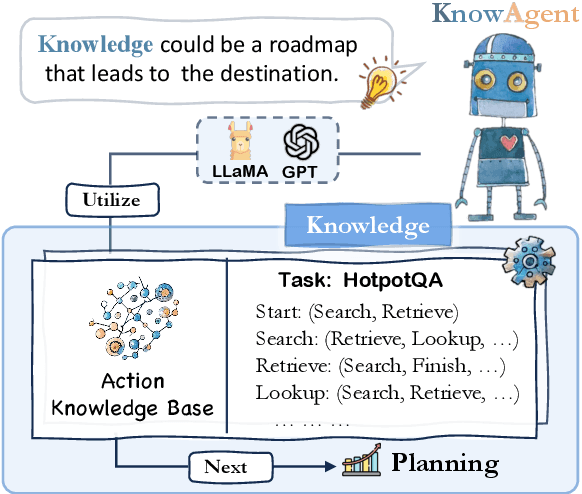
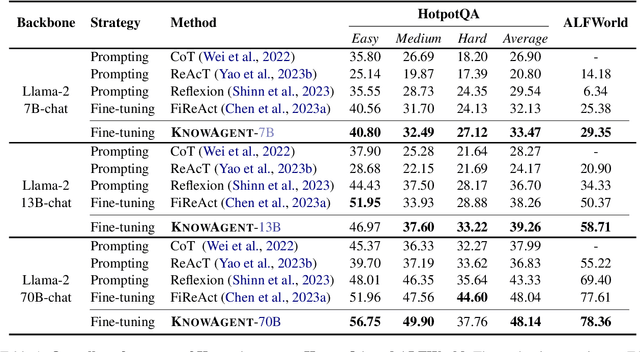
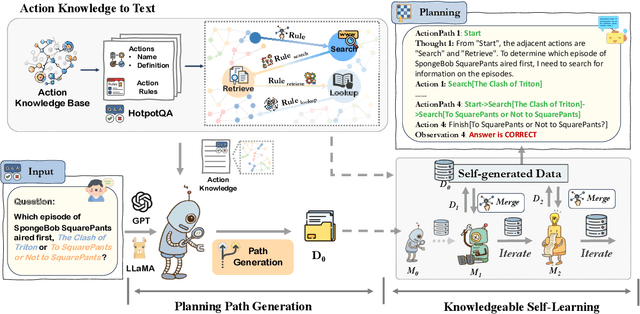

Abstract:Large Language Models (LLMs) have demonstrated great potential in complex reasoning tasks, yet they fall short when tackling more sophisticated challenges, especially when interacting with environments through generating executable actions. This inadequacy primarily stems from the lack of built-in action knowledge in language agents, which fails to effectively guide the planning trajectories during task solving and results in planning hallucination. To address this issue, we introduce KnowAgent, a novel approach designed to enhance the planning capabilities of LLMs by incorporating explicit action knowledge. Specifically, KnowAgent employs an action knowledge base and a knowledgeable self-learning strategy to constrain the action path during planning, enabling more reasonable trajectory synthesis, and thereby enhancing the planning performance of language agents. Experimental results on HotpotQA and ALFWorld based on various backbone models demonstrate that KnowAgent can achieve comparable or superior performance to existing baselines. Further analysis indicates the effectiveness of KnowAgent in terms of planning hallucinations mitigation. Code is available in https://github.com/zjunlp/KnowAgent.
 Add to Chrome
Add to Chrome Add to Firefox
Add to Firefox Add to Edge
Add to Edge